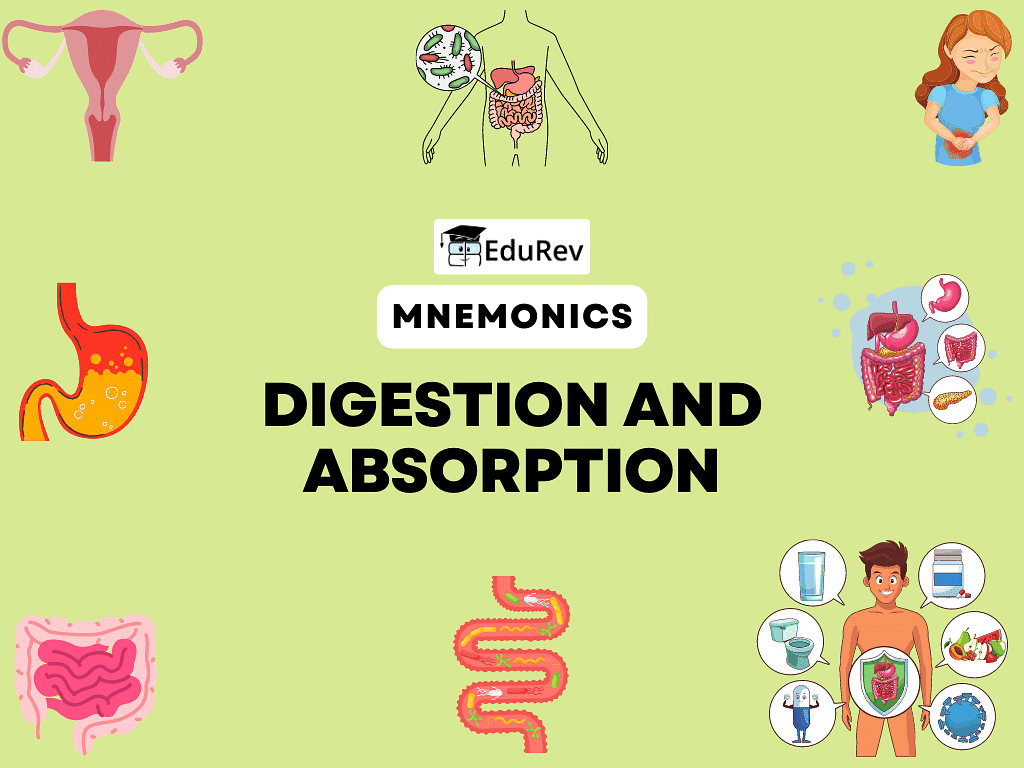Mnemonics: Digestion & Absorption (Old NCERT) | Crash Course for NEET PDF Download
| Table of contents |

|
| Enzymes in the Digestive System and their Locations |

|
| Enzymes from Small Intestine |

|
| Functions of the Liver |

|
| Functions of the Stomach Secretions |

|
This document will help you remember important information about Digestion & Absorption in a fun and easy way. Inside, you'll find mnemonics—memory tricks—that will make it easier for you to remember key concepts, examples, and classifications related to Digestion & Absorption.

Whether you're studying for an exam, preparing for a quiz, or simply looking to enhance your understanding of Digestion & Absorption, these mnemonics will serve as valuable memory tools. Utilize them alongside your regular study routine to reinforce your knowledge and increase your recall ability.
Happy mnemonic learning!
Enzymes in the Digestive System and their Locations
Mnemonic: "SALiVary PArtners Live Side by Side"
- S - Salivary amylase (Salivary glands): Salivary amylase is produced in the salivary glands and begins the digestion of starches in the mouth.
- A - Amylase (Pancreas): Amylase is produced in the pancreas and continues the digestion of starches in the small intestine.
- L - Lipase (Pancreas): Lipase, also produced in the pancreas, breaks down fats (lipids) into fatty acids and glycerol in the small intestine.
- V - Trypsin (Pancreas): Trypsin is another pancreatic enzyme that helps break down proteins into smaller peptides in the small intestine.
- P - Pepsin (Stomach): Pepsin is found in the stomach and is responsible for breaking down proteins into smaller peptides.
- A - Aminopeptidase (Small intestine): Aminopeptidase is present in the small intestine and helps further break down peptides into individual amino acids.
- L - Lactase (Small intestine): Lactase is an enzyme in the small intestine that breaks down lactose (milk sugar) into glucose and galactose.
- S - Sucrase (Small intestine): Sucrase breaks down sucrose (table sugar) into glucose and fructose in the small intestine.
- S - Maltase (Small intestine): Maltase breaks down maltose (malt sugar) into two glucose molecules in the small intestine.
- B - Brush border enzymes (Small intestine): Brush border enzymes refer to a group of enzymes located on the surface of the small intestine's epithelial cells (brush border). These enzymes include various peptidases and disaccharidases, such as lactase, maltase, and sucrase, which assist in the final breakdown of peptides and disaccharides into amino acids and monosaccharides, respectively.
Enzymes from Small Intestine
Mnemonic: SMELL
Success Entricus Released From Small Intestine's Crypts of Leiberkutus
- S: Sucrase: For Sucrase
- M: Maltase: For Maltose
- E: Erepsin: For Peptone
- L: Lactase: For Lactose
- L: Lipase: For Fat
Mnemonic Explanation: The mnemonic "SMELL" can help you remember some of the enzymes produced by the small intestine: Sucrase, Maltase, Erepsin, Lactase, and Lipase. Each letter in the mnemonic corresponds to the first letter of an enzyme's name.
Functions of the Liver
Mnemonics: PHAT LiVeR
- P - Production of bile
- H - Homeostasis of blood glucose
- A - Amino acid metabolism
- T - Toxin detoxification
- LiVeR - Lipid metabolism, Vitamin storage, RBC breakdown
Mnemonic Explanation: Production of bile, which helps with lipid digestion and absorption. Homeostasis of blood glucose, regulating glucose levels in the bloodstream. Amino acid metabolism, involved in the breakdown and synthesis of amino acids. Toxin detoxification, the liver plays a vital role in filtering and neutralizing toxins in the body. Lipid metabolism, involving the synthesis and breakdown of fats. Vitamin storage, as the liver stores certain vitamins for future use. RBC breakdown, where old red blood cells are broken down and their components recycled.
Functions of the Stomach Secretions
Mnemonic: GAP
- G - Gastric lipase: This enzyme, found in the stomach, begins the digestion of dietary fats into fatty acids and glycerol.
- A - Acid: The stomach secretes hydrochloric acid, creating an acidic environment that aids in pepsinogen activation and kills harmful bacteria.
- P - Pepsin: As mentioned earlier, pepsin is responsible for breaking down proteins into smaller peptides.
|
120 videos|67 docs
|






















